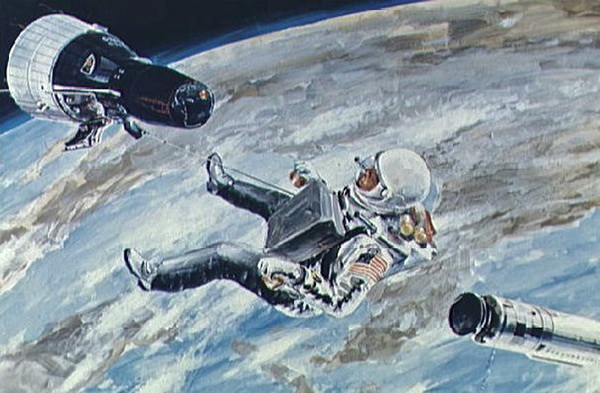NASA's Barnstorming Gemini Capsule-Moon Plan
NASA's Barnstorming Gemini Capsule-Moon Plan
In the heat of the Space Race in the early 1960s engineers thought up a wild barnstorming scheme for getting Americans to moon before the Soviets. Rather than wait for the development of the full-scale Apollo vehicle, they considered hot-rodding a two-man Gemini capsule intended for Earth orbit to sprint across 240,000 miles to do reconnaissance of the moon. A seat-of-pants lunar landing was even imagined.
Under the shadow of a string of Soviet space triumphs, in 1961 president John F. Kennedy set NASA’s daunting goal to land astronauts on the moon before 1970. A methodical manned spaceflight program was laid out to culminate in a lunar touchdown by a three-person Apollo capsule.
With the seating room smaller than inside a Volkswagen Beetle, the Gemini capsule was intended to allow Earth-orbiting astronauts to demonstrate proof-of concept for space docking, and also practicing spacewalks. With 12 missions planned to follow the last one-man Mercury capsule flight in May 15, 1963, the Gemini program was strictly Act II in the moon conquest game plan.
But the aerospace contractors McDonnell Aircraft, who built the Gemini capsule, and Martin Marietta, who built the Titan launch vehicle, wanted a piece of the high-profile lunar action.
To get a foot in the door they proposed hurtling a modified Gemini capsule onto a simple lunar round trip where astronauts would do photo reconnaissance of potential Apollo landing sites. Launched on a Saturn IB booster, a liquid fueled Centaur upper stage would kick the Gemini onto a so-called free-return trajectory around the moon. No additional rocket power would be needed to swing back to a splashdown on Earth.
This idea ratcheted up to putting a Gemini into a highly elliptical lunar orbit. The capsule would swoop only 10 miles above target Apollo landing sites. The space choreography was tricky. The Gemini capsule would be launched first on its military Titan booster. A few minutes later a second Titan would launched a so-called transtage that had the rocket power to head to the moon and back. The astronauts would dock their Gemini nose-first with the transtage and fire up its engine.
A big proponent of the Gemini moon mission, astronaut Pete Conrad convinced NASA to allow him to used the Agena stage they practiced docking with to boost himself and co-pilot Richard Gordon to a record-breaking altitude of 850 miles in 1966. This was a demonstration of how a Gemini moon mission would unfold.
The most far-out idea of all was the proposal to land two astronauts on the moon in a modified Gemini capsule. Proponents argued that the direct landing on the moon was simpler than the Apollo plan that called for a separate orbiter and lander that would need to rendezvous and dock above the lunar surface. A brawny Saturn V booster would still be needed to send the Gemini capsule moonward, mounted atop nested rocket motors and deployable landing legs.
The wildest idea of all was that the Gemini co-pilot would steer the lander by looking into a deployable rear-view mirror (caution: lunar surface may be closer than it appears). The capsule design meant that the astronaut pair would be landing on their backs! The command pilot needed to turn around and observe the lunar surface out of a World War II style bubble canopy added to the Gemini. An alternative was to depressurize the cabin and have the pilot stick his head out of the capsule’s opened hatch on the way down! Yee-haw! talk about space cowboys.
All these scenarios suffered an early death because NASA was already developing five robotic lunar orbiters that had their own miniaturized onboard photo labs — built by none other than Eastman Kodak — to chemically process lunar photos, digitize them, and radio the images back to Earth.
If the orbiters failed NASA had an ambitious manned reconnaissance scheme called the Apollo Lunar Mapping and Survey System. Using technology developed for military space surveillance, a modified Apollo capsule with a spy-satellite “nose” would obit the moon and the astronauts would take gobs of pictures.
NASA didn’t need a third backup plan.
Several years before Sputnik was launched just such a mission was illustrated on the Disneyland television series. To add melodrama for the Sunday night TV audience, Walt Disney had the astronaut crew stumble upon an alien base on the lunar farside!
The Gemini scheme too would have been a unique and melodramatic episode NASA’s pioneering journey to the moon.
Feb 1, 2013 02:15 PM ET by Ray Villard












